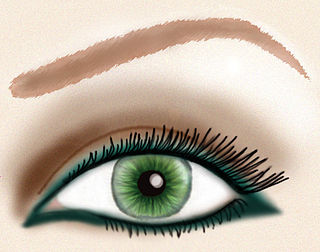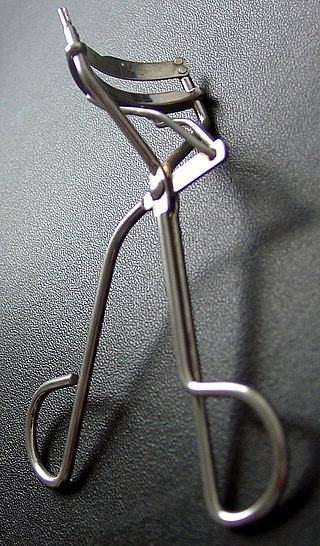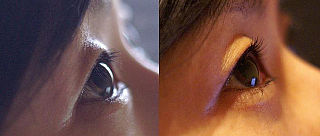
Cosmetics are constituted mixtures of chemical compounds derived from either natural sources, or synthetically created ones. Cosmetics have various purposes. Those designed for personal care and skin care can be used to cleanse or protect the body or skin. Cosmetics designed to enhance or alter one's appearance (makeup) can be used to conceal blemishes, enhance one's natural features, add color to a person's face, or change the appearance of the face entirely to resemble a different person, creature or object. Cosmetics can also be designed to add fragrance to the body.

Mascara is a cosmetic commonly used to enhance the upper and lower eyelashes. It is used to darken, thicken, lengthen, and/or define the eyelashes. Normally in one of three forms—liquid, powder, or cream—the modern mascara product has various formulas; however, most contain the same basic components of pigments, oils, waxes, and preservatives. The most common form of mascara is a liquid in a tube with an application brush.

Cosmetology is the study and application of beauty treatment. Branches of specialty include hairstyling, skin care, cosmetics, manicures/pedicures, non-permanent hair removal such as waxing and sugaring, and permanent hair removal processes such as electrology and intense pulsed light (IPL).

An eyelash is one of the hairs that grows at the edge of the eyelids. It grows in one layer on the edge of the upper and lower eyelids. Eyelashes protect the eye from debris, dust, and small particles and perform some of the same functions as whiskers do on a cat or a mouse in the sense that they are sensitive to being touched, thus providing a warning that an object is near the eye.

A permanent wave, commonly called a perm or permanent, is a hairstyle consisting of waves or curls set into the hair. The curls may last a number of months, hence the name.
Artificial hair integrations, more commonly known as hair extensions, hair weaves, and fake hair add length and fullness to human hair. Hair extensions are usually clipped, glued, or sewn on natural hair by incorporating additional human or synthetic hair. These methods include tape-in extensions, clip-in or clip-on extensions, micro/nano rings, fusion method, weaving method, and wigs.

Permanent makeup, also known as permanent cosmetics, derma-pigmentation, micro-pigmentation, and cosmetic tattooing, is a cosmetic technique which employs tattoos as a means of producing designs that resemble makeup, such as eye-lining and other permanent enhancing colors to the skin of the face, lips, and eyelids. It is also used to produce artificial eyebrows, particularly in people who have lost them as a consequence of old age, disease, such as alopecia totalis, chemotherapy, or a genetic disturbance, and to disguise scars and hypopigmentation in the skin such as in vitiligo. It is also used to restore or enhance the breast's areola, such as after breast surgery.

Eye liner or eyeliner is a cosmetic used to define the eyes. It is applied around the contours of the eye(s). It is often used to create various aesthetic effects.

Charles Nessler was the inventor of the permanent wave.

The history of cosmetics spans at least 7,000 years and is present in almost every society on earth. Cosmetic body art is argued to have been the earliest form of a ritual in human culture. The evidence for this comes in the form of utilised red mineral pigments including crayons associated with the emergence of Homo sapiens in Africa. Cosmetics are mentioned in the Old Testament—2 Kings 9:30 where Jezebel painted her eyelids—approximately 840 BC—and the book of Esther describes various beauty treatments as well.

Cosmetics in the 1920s were characterized by their use to create a specific look: lips painted in the shape of a Cupid's bow, kohl-rimmed eyes, and bright cheeks brushed with bright red blush.

An eyelash curler is a hand-operated mechanical device for curling eyelashes for cosmetic purposes. Usually only the upper eyelashes are curled.
Madarosis is a condition that results in the loss of eyelashes, and sometimes eyebrows. The term "madarosis" is derived from the ancient Greek "madaros", meaning "bald". It originally was a disease of only losing eyelashes but it currently is the loss of both eyelashes and eyebrows. Eyebrows and eyelashes are both important in the prevention of bacteria and other foreign objects from entering the eye. A majority of patients with madarosis have leprosy, and it was reported that 76% of patients with varying types of leprosy had madarosis.

Artificial nails, also known as fake nails, false nails, acrylic nails, nail extensions or nail enhancements, are extensions placed over fingernails as fashion accessories. Many artificial nail designs attempt to mimic the appearance of real fingernails as closely as possible, while others may deliberately stray in favor of an artistic look.
Cosmetics, first used in ancient Rome for ritual purposes, were part of daily life. Some fashionable cosmetics, such as those imported from Germany, Gaul and China, were so expensive that the Lex Oppia tried to limit their use in 189 BCE. These "designer brands" spawned cheap knock-offs that were sold to poorer women. Working-class women could afford the cheaper varieties, but may not have had the time to apply the makeup as the use of makeup was a time-consuming affair because cosmetics needed to be reapplied several times a day due to weather conditions and poor composition.
Eyelash implants are a form of cosmetic surgery involving transplanting additional eyelashes around the eye. The process typically involves removing a section of hair from the patient, typically from the back of the head, and grafting the hair to the eyelids, replacing the existing eyelashes. The procedure typically involves 60 to 70 hairs per eye, and after removal and a thorough cleaning of the oil on the hair, they are reattached to patient by delicately sewing the lashes back on. Maintenance of the eyelashes is needed thereafter, as the hair continues to grow at the same rate as on other parts of the body.

Eyelash permanent wave, or more commonly called an eyelash perm, and may also refer to permanent relaxer that straightens the hair is a cosmetics procedure performed only by licensed Cosmetologists to flip up eyelashes using hair perming technology.

Huda Beauty is a cosmetics line that was launched in 2013 by Huda Kattan. Her older sister, Alya Kattan, initially helped her by financially contributing to the setup of the business. Huda Kattan was chosen as one of "The 25 Most Influential People on the Internet" by Time in 2017, and she was listed as one of The Richest Self-Made Women and one of the Top Three Beauty Influencers by Forbes.

Victorian-era cosmetics refers to cosmetic products used during the Victorian age. Victorian cosmetics were often toxic or otherwise damaging. Commonly used products included ingredients such as lead, mercury, arsenic, and ammonia.
Codilia Gapare is a UK based Zimbabwean magistrate and entrepreneur who invented the first ever false lashes range for chemotherapy patients and those suffering hair loss, she is the founder and CEO of C-Lash.















